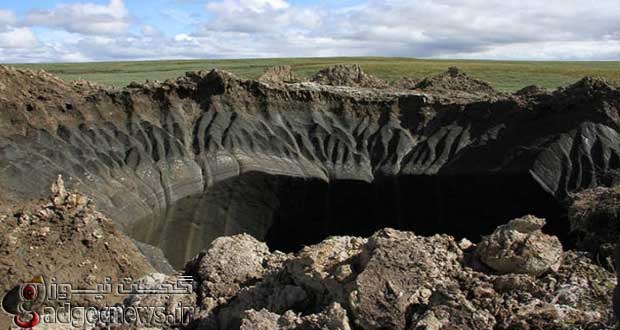محققان همچنان به سختی در تلاش هستند تا راز گودال عظیمی که در سیبری ایجاد شده را کشف کنند.
آنطور که از سوی منابع دولتی روسیه اعلام شده، سنگهای آسمانی منشا این حفره عظیم نبودهاند و خاک مجاور ورودی این گودال حکایت از بروز انفجاری عظیم در داخل زمین دارند. البته هنوز هیچ اطلاعی درباره زمان به وجود آمدن این حفره در دسترس نیست.
این حفره در 2880 کیلومتری شرق مسکو و در منطقهای با گونههای متنوع جانوری واقع شده است که یکی از نواحی کلیدی و استراتژیک روسیه در تولید گاز و نفت میباشد.
آثار به جا مانده در دیواره لبه حفره حکایت از وجود گرمای فراوان حاصل از انفجار دارد. اعضای آکادمی علوم روسیه با جمعآوری نمونههای خاک، هوا و آب این منطقه در حال بررسی موضوع هستند. این گودال قطر خارجی در حدود 61 متر و قطر داخلی در حدود 40 متر دارد.
Andrey Plekhanov محقق ارشد مرکز تحقیقاتی آرکتیک دراین باره میگوید: این حفره دهانهای بیضوی دارد و همین مساله اندازهگیری دقیق قطر آن را با مشکل مواجه میکند. عمق این گودال نیز چیزی در حدود 50 تا 70 متر است. در کف این حفره نیز یک دریاچه یخی وجود دارد که آب از بدنه گودال بر روی آن سرازیر میشود.
منبع:sploid.gizmodo
English Version
English Version
Mysterious giant hole suddenly appears in Siberia A mysterious giant hole and crater have suddenly appeared in Siberia, Russia. There are not many details right now, but the video captured from a helicopter shows a weird configuration with debris and signs of combustion around it. What the hell is this? Update: New pictures and video show the interior of the hole in detail. The hole is about 262 feet (80 meters) in diameter and it certainly doesn’t look like a sinkhole, although you can see a large cavern under it. The video was filmed from a helicopter over the Yamal Peninsula, the location of major gas fields discovered in 1972 and currently being exploited by the Russian energy giant Gazprom. Of course, the internet is now raging with rumors about UFOs getting in or out of our planet’s crust. The reality may be less exciting than that. The Siberian Times reports: Anna Kurchatova from Sub-Arctic Scientific Research Centre thinks the crater was formed by a water, salt and gas mixture igniting an underground explosion, the result of global warming. She postulates that gas accumulated in ice mixed with sand beneath the surface, and that this was mixed with salt – some 10,000 years ago this area was a sea. That sounds like the most likely possibility indeed. At least more plausible than the alternative theories: Meteors, giant worm from hell coming out of its lair, and drilling UFOs. According to the Russian paper, there’s an expedition on its way that “includes two experts from the Centre for the Study of the Arctic and one from Cryosphere Institute of the Russian Academy of Sciences. They plan to take samples of soil, air and water from the scene.” Talking to The Sydney Morning Herald, polar scientist Dr. Chris Fogwill says it’s likely to be a geological phenomenon called a pingo—a block of ice that’s grown into a small hill in the frozen arctic ground: The permafrost [frozen earth] can be hundreds of metres thick, allowing for large ice features. This is obviously a very extreme version of that, and if there’s been any interaction with the gas in the area, that is a question that could only be answered by going there. We’re seeing much more activity in permafrost areas than we’ve seen in the historical past. A lot of this relates to this high degree of warming around these high arctic areas which are experiencing some of the highest rates of warming on earth.
 گجت نیوز آخرین اخبار تکنولوژی، علم و خودرو
گجت نیوز آخرین اخبار تکنولوژی، علم و خودرو 














